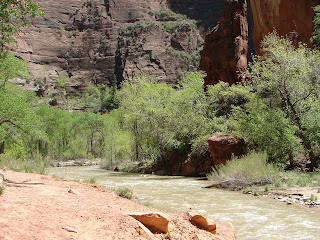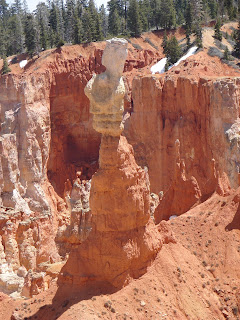Zion National Park - Utah
 Zion National Park is the oldest and most visited park in Utah. In 2009 the Park will celebrate it's 100th birthday.
Zion National Park is the oldest and most visited park in Utah. In 2009 the Park will celebrate it's 100th birthday.

Zion Park is made up of over 5,000 feet of vertical relief in which lay deep sandstone canyons, stricking rock towers and high mesas and plateaus. There is great camping within the park and hiking trails for every person's ability, from the very easy to the extremely strenuous.

Sometimes "herds" of bikers are seen riding on the winding hilly roads. It would be a great place to camp for a couple weeks sometime; except for the crowds of people who also like this destination in the summer time.
 The park elevation ranges from 3,600 to 8,700 feet and is home to an amazing array of birds and plants, including my favorite red Indian Paintbrush flower. Mountion lions, elk, the desert tortoise, and bird species as small as the black-chinned hummingbird to as large as the Peregrine falcon all live within the Zion National Park. I may not have seen all these animals, but I did see the Steller Jay and the Indian Paintbrush flower.
The park elevation ranges from 3,600 to 8,700 feet and is home to an amazing array of birds and plants, including my favorite red Indian Paintbrush flower. Mountion lions, elk, the desert tortoise, and bird species as small as the black-chinned hummingbird to as large as the Peregrine falcon all live within the Zion National Park. I may not have seen all these animals, but I did see the Steller Jay and the Indian Paintbrush flower.





Vertical monolithes made of Navajo Sandstone comprises the 2,000 high cliffs. The sandstone consists of grains of quartz held together with a "weak" cement, most likely limestone.

 Life within Zion National Park is sustained by the Virgin River which flows through the canyon on its journey to converge with the Colorado River.
Life within Zion National Park is sustained by the Virgin River which flows through the canyon on its journey to converge with the Colorado River.

The building to the right was the original Visitor Center in Zion Park. Due to the increase of tourists, today's Visitor Center is many times larger and a grocery store and general store are nearby.







This amazing "picture window" appears before you at the end of one of the two tunnels along the road in the Park.

Indian Paintbrush

This grand cave (or so it appears) has been carved into the stone to allow light into the car tunnel.

We were camped at the Elks Lodge in St. George, UT. The electricity is 20amps at best with this many rigs, but the surrounding red sandstone makes up for the lesser electricity. Just across the parking lot is a beautiful golf course. This was a good place to stay for a few days while we visited the Utah National Parks.


Coming into Zion National Park from the west we passed through a small area known as Red Canyon. The area blew me away with the stunning red color! What an entrance!

 The park elevation ranges from 3,600 to 8,700 feet and is home to an amazing array of birds and plants, including my favorite red Indian Paintbrush flower. Mountion lions, elk, the desert tortoise, and bird species as small as the black-chinned hummingbird to as large as the Peregrine falcon all live within the Zion National Park. I may not have seen all these animals, but I did see the Steller Jay and the Indian Paintbrush flower.
The park elevation ranges from 3,600 to 8,700 feet and is home to an amazing array of birds and plants, including my favorite red Indian Paintbrush flower. Mountion lions, elk, the desert tortoise, and bird species as small as the black-chinned hummingbird to as large as the Peregrine falcon all live within the Zion National Park. I may not have seen all these animals, but I did see the Steller Jay and the Indian Paintbrush flower.




Vertical monolithes made of Navajo Sandstone comprises the 2,000 high cliffs. The sandstone consists of grains of quartz held together with a "weak" cement, most likely limestone.

 Life within Zion National Park is sustained by the Virgin River which flows through the canyon on its journey to converge with the Colorado River.
Life within Zion National Park is sustained by the Virgin River which flows through the canyon on its journey to converge with the Colorado River.
The building to the right was the original Visitor Center in Zion Park. Due to the increase of tourists, today's Visitor Center is many times larger and a grocery store and general store are nearby.







This amazing "picture window" appears before you at the end of one of the two tunnels along the road in the Park.


Indian Paintbrush

This grand cave (or so it appears) has been carved into the stone to allow light into the car tunnel.

We were camped at the Elks Lodge in St. George, UT. The electricity is 20amps at best with this many rigs, but the surrounding red sandstone makes up for the lesser electricity. Just across the parking lot is a beautiful golf course. This was a good place to stay for a few days while we visited the Utah National Parks.


Coming into Zion National Park from the west we passed through a small area known as Red Canyon. The area blew me away with the stunning red color! What an entrance!
























